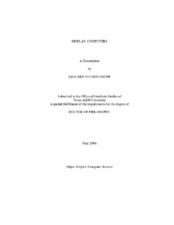Display computers
Abstract
A Display Computer (DC) is an everyday object: Display Computer = Display +
Computer. The “Display” part is the standard viewing surface found on everyday
objects that conveys information or art. The “Computer” is found on the same everyday
object; but by its ubiquitous nature, it will be relatively unnoticeable by the DC user, as
it is manufactured “in the margins”. A DC may be mobile, moving with us as part of the
everyday object we are using. DCs will be ubiquitous: “effectively invisible”, available
at a glance, and seamlessly integrated into the environment. A DC should be an example
of WeiserÂ’s calm technology: encalming to the user, providing peripheral awareness
without information overload. A DC should provide unremarkable computing in support
of our daily routines in life. The nbaCub (nightly bedtime ambient Cues utility buddy)
prototype illustrates a sample application of how DCs can be useful in the everyday
environment of the home of the future. Embedding a computer into a toy, such that the
display is the only visible portion, can present many opportunities for seamless and nontraditional
uses of computing technology for our youngest user community. A field
study was conducted in the home environment of a five-year old child over ten
consecutive weeks as an informal, proof of concept of what Display Computers for
children can look like and be used for in the near future. The personalized nbaCub
provided lightweight, ambient information during the necessary daily routines of
preparing for bed (evening routine) and preparing to go to school (morning routine). To
further understand the childÂ’s progress towards learning abstract concepts of time
passage and routines, a novel “test by design” activity was included. Here, the role of
the subject changed to primary designer/director. Final post-testing showed the subject knew both morning and bedtime routines very well and correctly answered seven of
eight questions based on abstract images of time passage. Thus, the subject was in the
process of learning the more abstract concept of time passage, but was not totally
comfortable with the idea at the end of the study.
Subject
Display ComputersVisionary Computing
Ubiquitous Computing
Calm Technology
Test by Design
Children's Computing Applications
Citation
Smith, Lisa Min-yi Chen (2006). Display computers. Doctoral dissertation, Texas A&M University. Texas A&M University. Available electronically from https : / /hdl .handle .net /1969 .1 /3829.
Related items
Showing items related by title, author, creator and subject.
-
Crews, Phillip Lee (Texas A&M University. Libraries, 1977)The objective of this dissertation is to describe the design considerations for a computer architecture capable of directly executing multiple high order languages (HOL) thereby eleiminating the need to translate source ...
-
Labib, Rania (12th Advanced Building Skins Conference, 2017-10-02)
-
Morgan , Beth Media Resources, College of Veterinary Medicine


